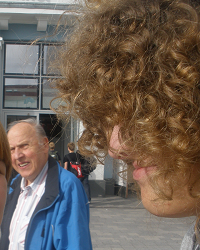eduard
About
- Username
- eduard
- Joined
- Visits
- 1,402
- Last Active
- Roles
- Member, Moderator
Comments
-
Hi Parishad, Provided that the Tablet is compatible with Opensesame, you can absolutely implement such a paradigm. You need to use Python inline coding, specifically, the Mouse object and the Canvas object. The specific implementation could be a l…
-
Great, Fab!
-
Hi, This sounds like a specific question for the GazeRecorder people. Perhaps you want to check their FAQ or ask them how their data is structured? (At least, I have never seen those files, so I can't tell you what information is provided in which …
-
Hi Jessie, Do you mean you use a text_input form? Forms aren't really useful for retrieving accurate response times, because of the way they are implemented. What time are you interested in exactly? If it is the time until the first keystroke, ther…
-
Indeed, I wrote Python code which is not compatible with Online experimenting. You would need to translate the code to Javascript (and use the javascript inline_script item). Most of the code should be easily copied without any changes, but I am not…
-
Hi, the second trial block is not running You need to reset block_dur . Otherwise it will already be at the start larger than 30s the run time for the first trial block is variable Because the duration of the items inside the actual loop is not in …
-
You can either use forms with the button widgets, or potentially also the cursor_roi functionality. Give it a try and let us know whether it works. Eduard
-
but it only runs through 1 'trial' It runs through only one trial, because your experiment is only contains a single iteration of one loop. If you set the number of repeats to a high number (higher than the expected 120s duration, it should work lik…
-
I am quite sure the code works. Can you share your experiment, I shall try to see what is going on
-
Hi, The = is a special character in the loop table. If you put it in there Opensesame tries to interpret what follows as Python code. As there is nothing following, you'll get the Syntaxerror. A workaround is to save the equal as a variable and lo…
-
Hi, when using this, the entire task times-out at 30000 ms, rather than the trial block There is only one block in the experiment. Sop ending the block means ending the experiment. the trial does not run for a complete 30000 ms I suppose you mean 3…
-
@Fab can you help out?
-
Hi, You can start a timer in Python before the circle loop, and update it inside the loop. Set the break if statement of the loop to "whenever the timer runs longer than 120 seconds" and you should be set. See this example. https://forum…
-
You have two options. 1) allow multiple inputs into the same text_input form 2) allow only one item per text input form, but run that form multiple times. The first has the advantage that your experiment becomes super easy, and has the disadvantag…
-
Hi Pieter, Sketchpads with a duration of 0 are nothing extraordinary actually and normally work in Osweb just fine. So if unsetting it really made a difference, I guess that the behavior of other parts of the experiment caused the problem that onl…
-
Hi, You are trying to execute a Python inlineScript in Osweb. That isn't possible (Python code is not supported in the browser). You need to use a javascript inline script (and probably adapt your code some what). For more information see the docum…
-
Hi Manju, Please provide more info on your implementation. Without knowing what you did, I can't tell you what you did wrong. Probably you want to use a text input item to collect the responses, how it will look in your particular case, I can't te…
-
closed because of duplicate 6845
-
Hi Slobodan, Thanks, much clearer indeed. The question is whether the the run_if fields in sequences can be used in OSweb the same way as in Opensesame, specifically regarding dynamically setting them. I just had a quick go at it, but as far as I …
-
Hi Slobodan, When I try to put the sampler into the loot in your version of the experiment, it just doesn't stop it when the break comes. While this seems to be a potential bug in Opensesame, I am a bit confused why you can't use Lotje's example? T…
-
Hi Stéphanie, first step is to find out whether this is something about your experiment or a general problem with Opensesame. So, can you maybe try one of the default experiments? If the problem still occurs, a re-installation of the software might…
-
Hi Sarah, Unfortunately, it does only sometimes seem to update the value of the key "active" in the original dict / list, other times the original dict / list value for "active" is still "True", even though the functio…
-
Hi Pikachu (never thought I would ever say that...), However, I'm not sure about the frequency option of the synth item The frequency of the Synth item only specifies the pitch of the sound that is being played and has nothing to do with the rhythm…
-
`state["active"] == False That should be a single equal sign. Can you try fixing that? Eduard
-
Have you stored the return value of that function in the variable states again? The objects states in the function update_activity and states in your main script are different things. Changing it in the function will have no effect on the object…
-
That part: for state in states: if (state["step_size"] < state["exit_rule"] or state["upper_safe_amount"] > state["upper_lottery_amount"] or state["upper_safe_amount"] < states[…
-
Could you provide the complete error message?
-
def determine_state(states): l = random.randint(0,len(states) - 1) while not states[l]["active"]: l = random.randint(0,len(states) - 1) if states[l]["active"]: return l simplified version of …
-
Hi Sarah, You don't return anything. Can you try: `return I` in your function? Eduard
-
Can you share the experiment? Then I can recommend something based on your specific setup (please also include files if they are not already in the file pool) Eduard


